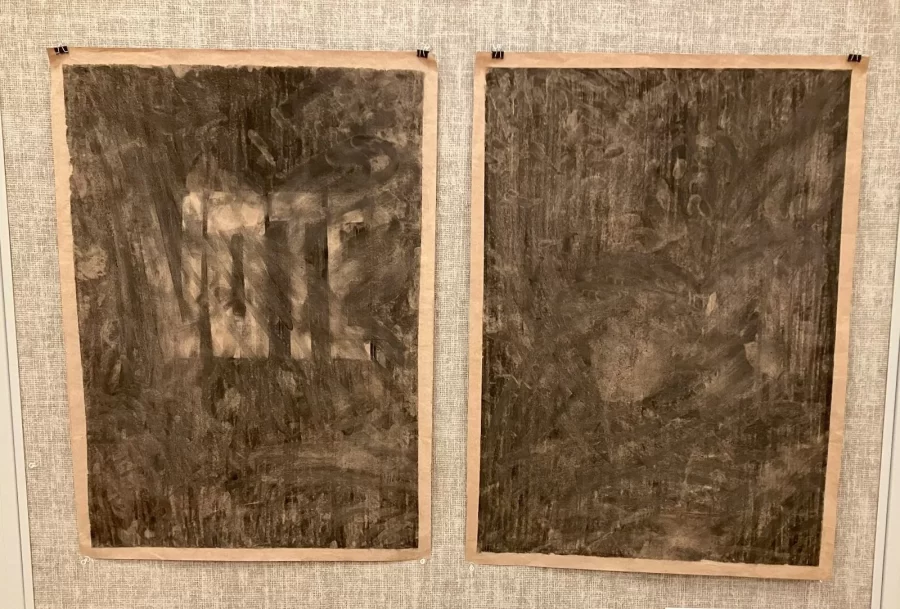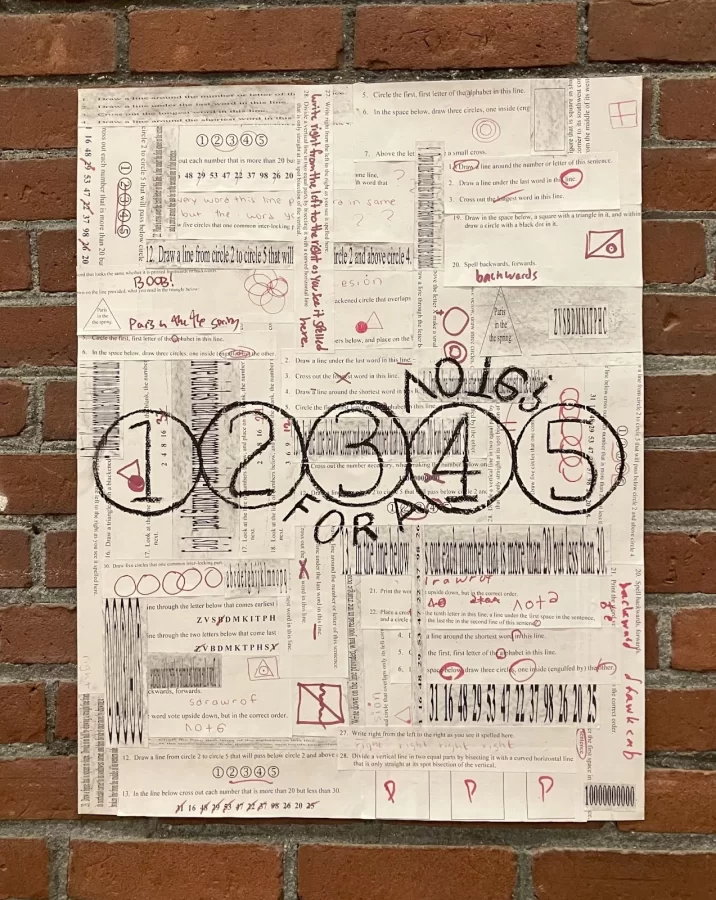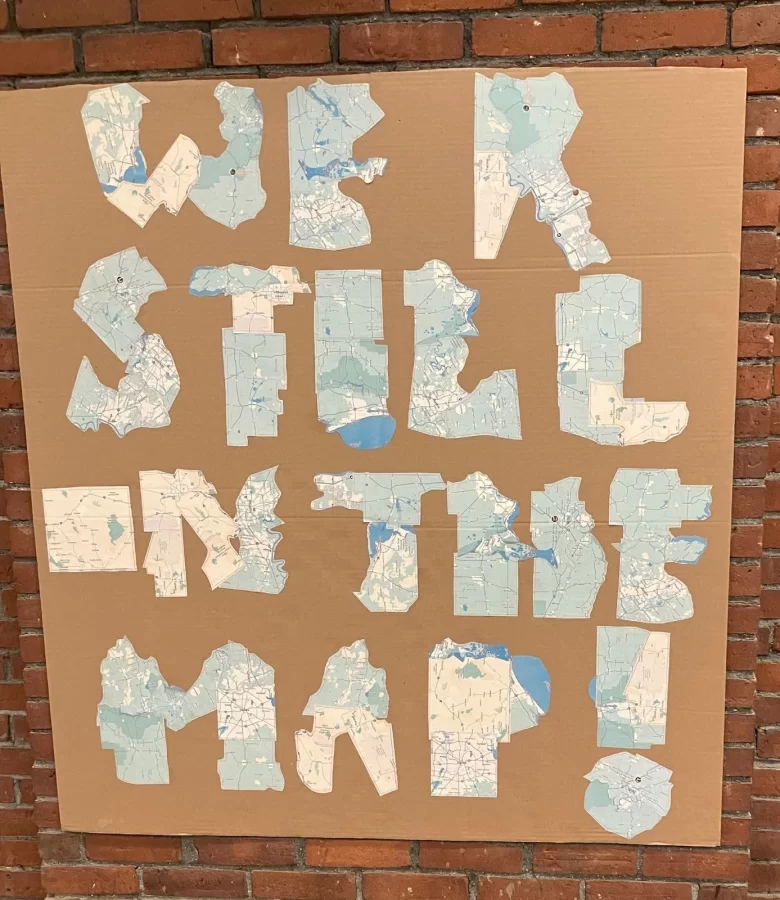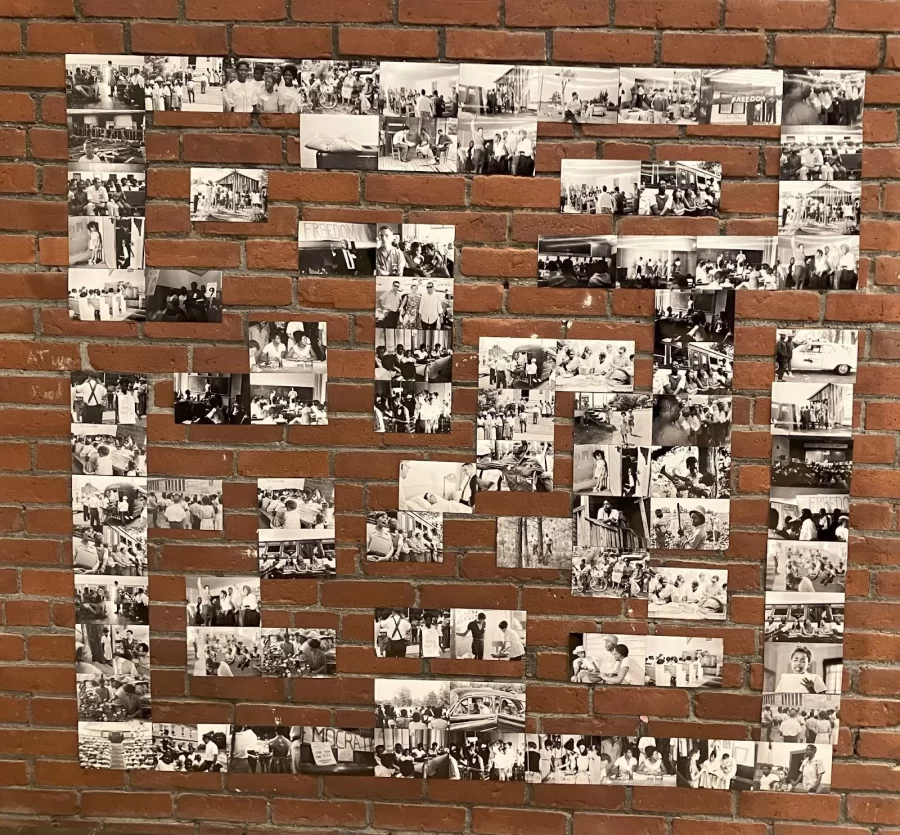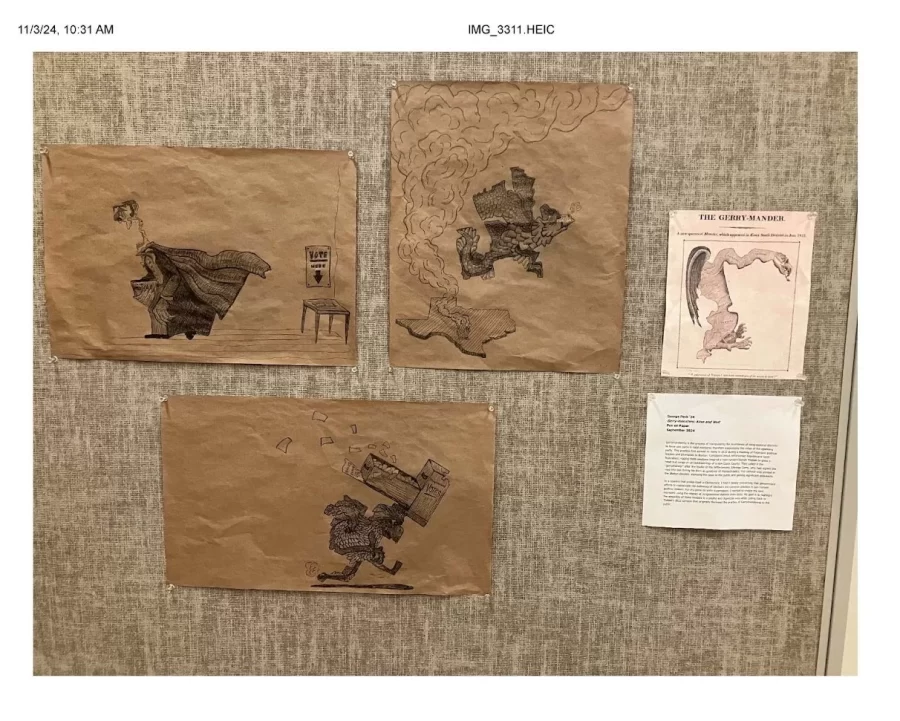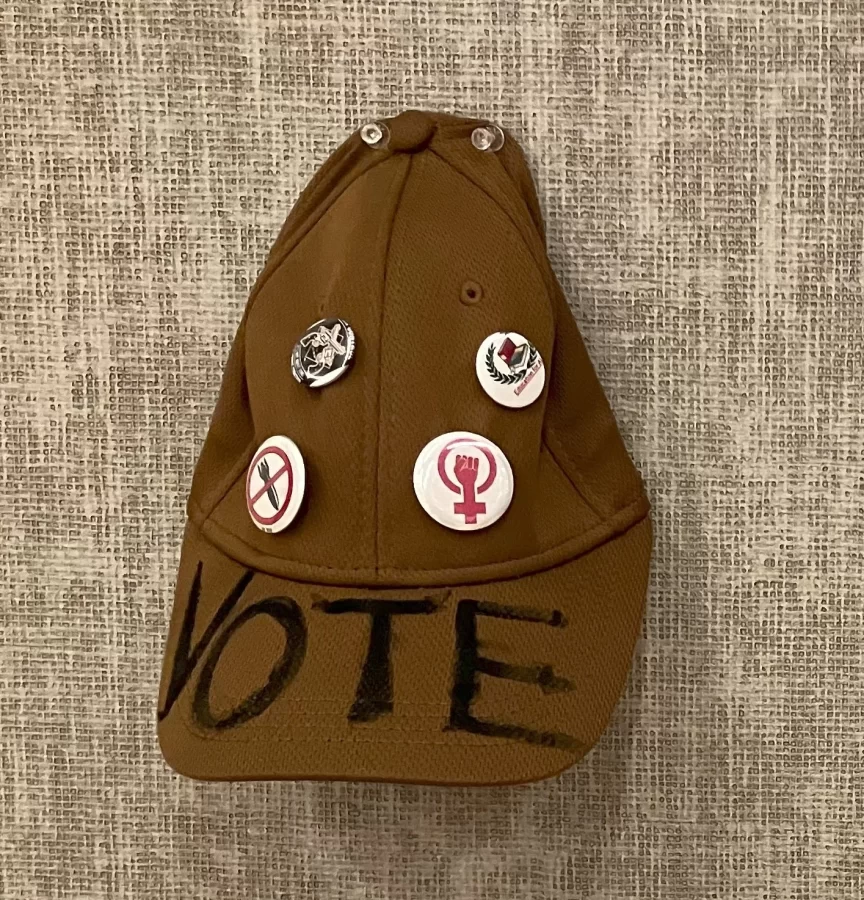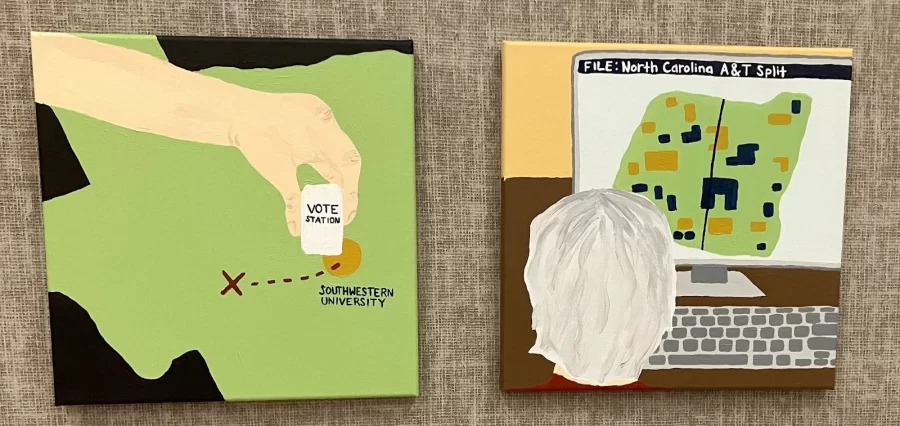Visual Explorations: Voter Suppression, Then and Now
In this semester’s “Visual Meaning: Process, Material, Format” course, professor Michel Droge is inviting students who are serious about making art to explore doing so from a research-based and conceptual standpoint. Working in various media, students are asked to respond in different ways to a shared theme. They research the theme, consider their own connection to it, and eventually decide how to visually convey its complexities and nuances.
With support from Project Pericles, a higher education civic engagement consortium, Droge focused the first assignment of the semester on the theme of voter suppression. With that topic in mind, students got to work researching voter suppression in different time periods, locations, populations, and so forth. Starting with a deep dive into the history of voter suppression in the U.S., students then considered a range of topics, including the role of race, power, and privilege in voter suppression; gerrymandering, redistricting, poll closures, and literacy tests as methods of suppressing the vote in certain populations; and voter intimidation on college and university campuses.
As their learning about voter suppression deepened and their research focus sharpened, Droge’s students also chose the medium that would best suit their project – for example, photography, collage, charcoal, or printmaking. Then the artists got to work creating, revising, peer reviewing each other’s work, receiving feedback from Droge, and revising again. Finally, they shared their work publicly through a Chase Hall exhibition entitled simply, “VOTE.” Snapshots from the exhibition opening, along with excerpts from the artist statements, are below.
Daniel Snider, ‘25
Disenfranchised
Leaves and Tape on Cardboard
The two maps, using information from 2016 published online by The Sentencing Project, depict rates of felony disenfranchisement–the percentage of the voting-age population in each state prevented from voting by law–across the United States. Darker areas correspond with higher rates of disenfranchisement, and lighter areas with lower rates. The upper map refers to total felony disenfranchisement rates, while the lower map refers to African-American felony disenfranchisement rates. . . My hope is that as the leaves dry and become disfigured, they convey a sense of slow alteration over time. . . We do not know what a map of disenfranchisement rates will look like in 20 or 50 years, but we can hope that it changes, that the dark colors fade, and that some of the barriers prohibiting people from participating in elections may crumble.
________________________________________________________________________________________
Danny Zuniga Zarat ‘25
Vote…
Charcoal on Kraft Paper
Despite the undeniable contribution of millions of undocumented immigrants to the American economy and overall cultural landscape, they are not allowed the right to participate in the electoral process. Like every other American, immigrants pay taxes and take their kids to school, yet they are denied the possibility of deciding their future. This piece seeks to represent the feelings of frustration and rejection that arise in moments like these, when the nation is ready to decide on its new chapter but is completely disregarding the voice and power of millions of immigrants living in this country.
________________________________________________________________________________________
Olivia Torrington, ‘27
The Unseen Vote, 2024
Digital Art, 42.5” x 11”
My piece incorporates official absentee application documents from Mississippi, a state with one of the most time-consuming, complicated absentee voting processes. By subverting and exaggerating these forms, I intend to expose the nonsensical and convoluted nature of this process. The absence of physical presence in both the process and my chosen digital medium reflects the distance absentee voters often feel from the voting system. In states like Mississippi, the process of voting absentee seems to be working against the voter, making it more difficult for absentee voters to engage in democracy. . . This work is not only a critique but also a call to action—encouraging viewers to reflect on the democratic process and the importance of fair access to voting for all.
________________________________________________________________________________________
Thea Stamoulis, ‘27
For A Vote?
Images of Louisiana State Literacy Test and Charcoal on Paper
[My] piece features the Louisiana State Literacy Test, which was a tool used in the 1960s to suppress African American citizens from obtaining the right to vote. The test was composed of 30 confusing questions, a 10 minute time limit, and a rule that one incorrect answer denoted failure, making it nearly impossible to pass. . . The collage was made via gluing and layering together pieces of scanned copies of. . . completed tests, as well as parts of edited questions from the test. The main subject, written in charcoal, is composed of two questions combined. Question 12 asks the applicant to “Draw a line from circle 2 to circle 5 that will pass below circle 2 and above circle 4.” Question 21 states, “Print the word vote upside down, but in the correct order.”
________________________________________________________________________________________
Miryam Keller, ‘25
1067
Cardboard, Paper
“1067” is a collage piece that explores voter suppression [created by] the Shelby County vs Holder decision of 2013. In the wake of that decision, 1,067 voting locations have closed in Texas, Arizona, Georgia, Louisiana, Mississippi, and Alabama. The words, “WE R STILL ON THE MAP!” are spelled out using printed maps of the counties with the highest number of closed voting locations. . . The text comes from an image of a handmade sign hung over the railing of an apartment porch in Louisiana. The goal of [my work] is to emphasize the counties that are most affected by poll closure by bringing them to the forefront of the map. . . I chose to focus on the Shelby County vs Holder decision [because] it impacts thousands of communities, specifically those of lower socio-economic status and communities of color. The text “WE R STILL ON THE MAP!” resonated with me as it speaks to erasure of voices and the fight to not be forgotten.
________________________________________________________________________________________
Avery Lehman ‘25
“Go to the Polls”
Inkjet Prints on Gloss Lustre 4”x 6” Photo Paper
“Go to the Polls” is a visual labyrinth containing 64 images taken by several participants of the 1964 Freedom Summer, a student and volunteer-led initiative to increase black voter registration in Mississippi. A majority of the volunteers and students participating were white, a strategic move due to the racist intimidation tactics and discrimination that black Americans were, and still are, subjected to in the South. This piece is situated amongst other works which visualize and interpret the issue of voter suppression in America, both presently and historically. While sourcing images for this project, I found the majority of the images to be depicting very ordinary scenes of the volunteers and students—many of whom were my age or younger at the time. I felt drawn to sharing the day-to-day scenes of this powerful project, whilst creating a participatory experience for the audience. The photographic maze which the viewer may attempt to solve symbolizes the barriers and challenges posed to Black Americans in the South throughout their attempts to become registered voters.
________________________________________________________________________________________
George Peck ‘24
Gerry-monsters: Alive and Well
Pen on Paper
Gerrymandering is the process of manipulating the boundaries of congressional districts to favor one party in local elections; therefore, suppressing the votes of the opposing party. This practice first earned its name in 1812 during a meeting of Federalist political leaders and journalists in Boston. Complaints about Jeffersonian Republicans (anti-federalists) rigging state elections inspired a man named Elkanah Tisdale to draw a head and wings on an outlined map of a new Essex County and named it the “gerrymander” after the leader of the Jeffersonians, Elbridge Gerry, who had signed the map into law during his term as governor of Massachusetts. The cartoon was printed in the Boston Gazette, where it exposed the issue to the public and gained significant popularity. In a country that prides itself on Democracy, I find it deeply concerning that government efforts to manipulate the outcomes of elections are common practice. For my piece on voter suppression, I wanted to create my own monsters using the shapes of congressional districts from 2022. My goal is to highlight the absurdity of these borders in a playful and digestible way while calling back to Tisdale’s 1812 cartoon that originally disclosed the practice of Gerrymandering to the public.
________________________________________________________________________________________
Kobby Nimako ‘26
GOTV
Cotton, Wool, Linen
Election merchandising has become increasingly influential in recent years, serving as a pivotal tool for engaging voters. This summer, while working on an election campaign, I observed a troubling lack of enthusiasm for voting among many individuals, especially millennials. This concern inspired me to create a piece that appeals to younger voters—a baseball hat that carries a powerful message about the importance of voting and the critical issues at stake in this election. The hat features buttons depicting images that reflect policies important to me. The chaotic arrangement of these buttons symbolizes the tumultuous and complex nature of the current political race. By merging everyday fashion with political activism, the piece aims to make voting a daily conversation and personal expression topic.
________________________________________________________________________________________
Grace Thomas ‘26
“Master of Modern Gerrymandering” and “Voting Out of Reach”
Acrylic on Canvas
I went into this project almost completely unaware that there was active voter suppression against [college] students. Now, I am still speechless by what I found during my research. [My first piece spotlights] Thomas Hofeller, a Republican political strategist and consultant on gerrymandering who used troves of data he collected on students at North Carolina’s largest historically Black college, North Carolina A&T University to split the campus in half to dilute Black students’ voting power. My second painting illuminates a different kind of voter suppression against college students. In 2019, the Texas legislature passed a bill that prevented the existence of short term early voting stations, [whose use had] helped increase access to voting for college students like those at Southwestern University in Texas. Knowing that student voters would turn out less because of a lack of nearby polling stations, lawmakers purposefully took this opportunity away.
As the exhibition’s curatorial statement notes: “We hope this exhibition raises awareness of the issues of voter suppression, inequities in communities, and the impact on our political ecosystem and society as a whole. We encourage you to continue these investigations in your communities, to address inequality and voter suppression on a local level. Raising awareness, especially for this often unseen issue, is the first step in making change.”

